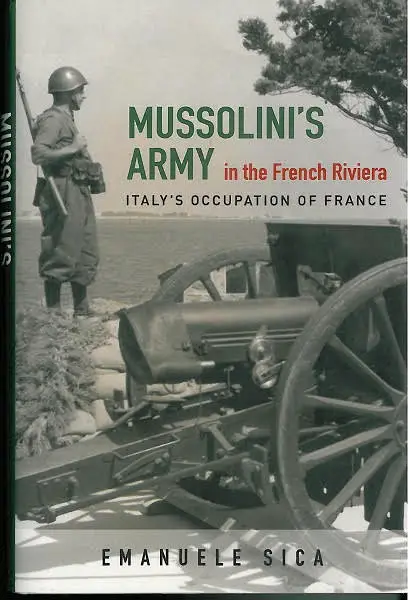I recently received and finished reading Emanuele Sica’s Mussolini’s Army in the French Riviera. The book was published as part of the University of Illinois Press’s The History of Military Occupation series. Sica offers an examination of the Italian involvement in France after the June 1940 surrender during WW2, first addressing the Italian demilitarized zone, then later the Italian occupation zone. I would rank it as a specialist’s book, offering a chronology of events and some details, but leaving me thinking the complexities have been simplified a bit too much. I wanted more details. He does push back against the idea that the occupation was shaped by ‘Italiani Brava Gente’ rather than polices and goals set by the Italian government. After I finished the book, I wondered if the Italian occupation had any real impact on the war. I would need to answer no. Besides the added strain on the Regio Esercito to garrison the area, the occupation had little advantage, if any for Italy.
In his introduction, Sica states that his analysis will examine the occupation at three different levels; as historical sociology rather than a purely national framework; the structural effects of occupation on the occupied society’s environmental and living conditions; and the face-to-face interactions between occupiers and occupied peoples (pg 9). All three levels would include a compare/contrast between the Italian occupation of France, the German occupation of France, and the Italian occupation of the Balkans. While this sounds good, it really didn’t work well in the book. Sica didn’t do all that much of this compare/contrast; the reader requires a decent background on the other two occupations to fully understand the context, and the long-term effects of the points compared weren’t offered to the reader. Where the compare/contrast does work is when Sica shows that the Italians could be ruthless, using their occupation of the Balkans to demonstrate that it was conditions and policies, more than ‘Italiani Brava Gente’, that shaped the nature of the occupation in France. This was a good point to highlight.
What Sica brings to the reader is that the Italian occupation wasn’t a story about the armed resistance to the occupiers, but the legal battles waged between the Italian and Vichy governments and the simultaneous internal conflict between the Regio Esercito and the Commissione Italiana per l’Armistizo con la Francia (CIAF). Treaties, laws, and regulations were the weapons of choice, not arrests, round-ups, executions, and the like. The first Italian soldier’s death due to partisan activity was on 27 April 1943. While there were earlier attacks, many of them were vendettas against individuals more than organized resistance. The similarities of the French and Italian peoples in terms of religions, culture, society, etc., combined with a careful/controlled use of regulations made this occupation distinctly different from others in Europe. Sica does provide some information on the Italian internment camps, including the harsh conditions and the sometimes arbitrary arrests that put people in the camps. The escape by French Jews from the Free Zone or from the German Occupation area into the Italian zone and their protection by the Italian occupation is another interesting point in this story. In all, the Italian long-term goals are examined, with discussions on how efficiently they were implemented and whether they were effective in achieving the goals.
The negatives for me included the lack of hard information provided on garrison size, locations, equipment, etc. There was little discussion of repartitions or the push by Italy to gain access to French military equipment. Given my interest is mainly military, I wanted a lot more on the activities of the military units. The November 1942 ‘invasion’ itself is addressed only with a very broad brush barely mentioned and the Italian involvement in the attempt to seize the French fleet is barely mentioned. The 1940 invasion and the results of the September 1943 surrender also lack detailed discussion. This is not a military history.
There was a lot of research supporting the book. For me, the bibliography cites, and endnotes (66 pages for the latter) were the added spice to the book, adding detail and pointing out areas for further research.
This is a niche area and this is the only book I am aware of in English that addresses this niche. If you have a strong desire to learn about this area of WW2 history, then I recommend this book. If you have a casual interest, then finding a library with the book is a better bet. One who has an interest in Axis occupations and resistance groups might find this as a starting point for research in this occupation.
